- Techniques
- One-Step Sparring
Taekwondo 태권도Taekwondo Preschool
In some schools, permission to begin sparring is granted upon entry. The rationale for this decision is that students must learn how to deal with a fast, powerful, and determined attacker. In other schools, students may be required to wait a few months, for safety reasons, because they must first build the skills they would ideally employ in their sparring practice. View Taekwondo Sparring »




One-Step Sparring
Sparring is a form of training common to many combat sports. Although the precise form varies, it is essentially relatively 'free-form' fighting, with enough rules, customs, or agreements to make injuries unlikely.
One-Step Sparring is performed with a partner in which predefined movements are practiced. One student is the attacker while the other student responds with defenses, counterattacks, and/or other actions, based on part of the predefined movements. This allows the student to understand what the movements are meant to accomplish in sparring or self-defense ( 호신술 hosinsool ) applications. It may also illustrate how to improve technique by adjusting distances, time moves properly, and adapt a technique depending on the size of an opponent.
Through analysis of the movement in variant scenarios, the student will unlock new techniques and expand their understanding of known ones. Some taekwondo schools require students to perform one-step sparring for promotion to the next belt level.
Strikers may combine techniques in a series to ensure one or more strikes impact their opponents. These attacks are thrown at various targets on the body, with the greatest force typically thrown with a particular technique in the sequence.
* Please see a certified Master Instructor ( 사범님 sabeomnim ) for training. Proper guidance and instructions are needed to ensure safe training.
One-Step Sparring
Promotion Tests Requirement
Students often undergo periodic testing and grading by their own Master Instructor ( 사범님 sabeomnim ) in order to advance to a higher level of recognized achievement such as a different belt color. They need to demonstrate their proficiency in the various aspects of the art such as the execution of patterns ( 품새 poomse ), which combine various techniques in specific sequences. Starting with coloured belts taekwondo students must learn one-step sparring. For more information on Promotion Tests »
( Click image for additional information)
Use in Demonstrations
To promote taekwondo for its emphasis on high kicking and fast hand techniques, taekwondo schools perform at tournaments, community events, shopping malls, parks, and tv shows. Demonstrations vary from school to school, but may include such elements as the execution of poomse ( 품새 poomse ), which combine various techniques in specific sequences; the breaking of boards to demonstrate the ability to use techniques with both power and control; sparring ( 겨루기 gyeorugi ) and self-defense ( 호신술 hosinsool ) to demonstrate the practical application and control of techniques; physical fitness usually with push-ups and sit-ups. For more information on Demonstrations »
( Click image for additional information)

Did you know? Taekwondo Preschool Master Edition Available Now
Taekwondo Preschool Master Edition


The book Taekwondo Preschool Master Edition provides in-depth information on the explosive and powerful techniques of taekwondo. There are lots of illustrations and interactive content within the master edition guidebook with over 1500+ pages. Are you prepared to learn the Korean Martial Arts! The book is available for download with Apple Books on your Mac or iOS device, and with iTunes on your computer. Books can be read with Apple Books on your Mac or iOS device.
View more information about the book »
- Taekwondo Stances ( 서기 sogi )
- Taekwondo Blocking ( 막기 makgi )
- Taekwondo Kicking ( 차기 chagi )
- Taekwondo Fist Strikes ( 지르기 jireugi )
- Taekwondo Strikes ( 치기 chigi )
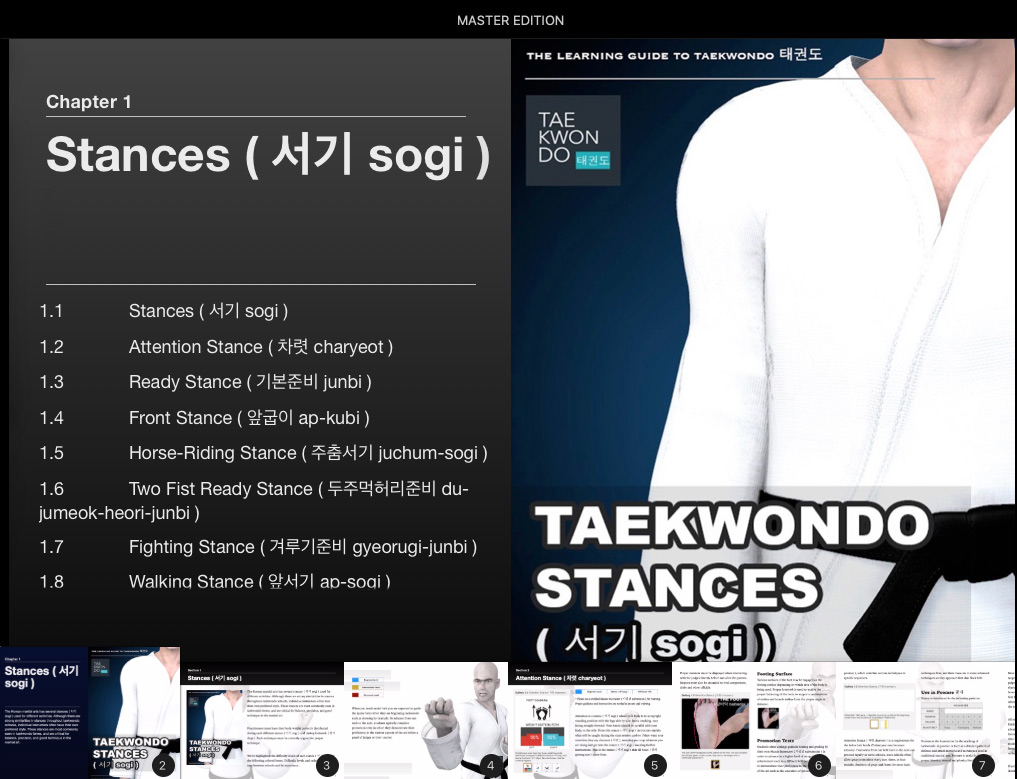
Taekwondo Preschool Master Edition

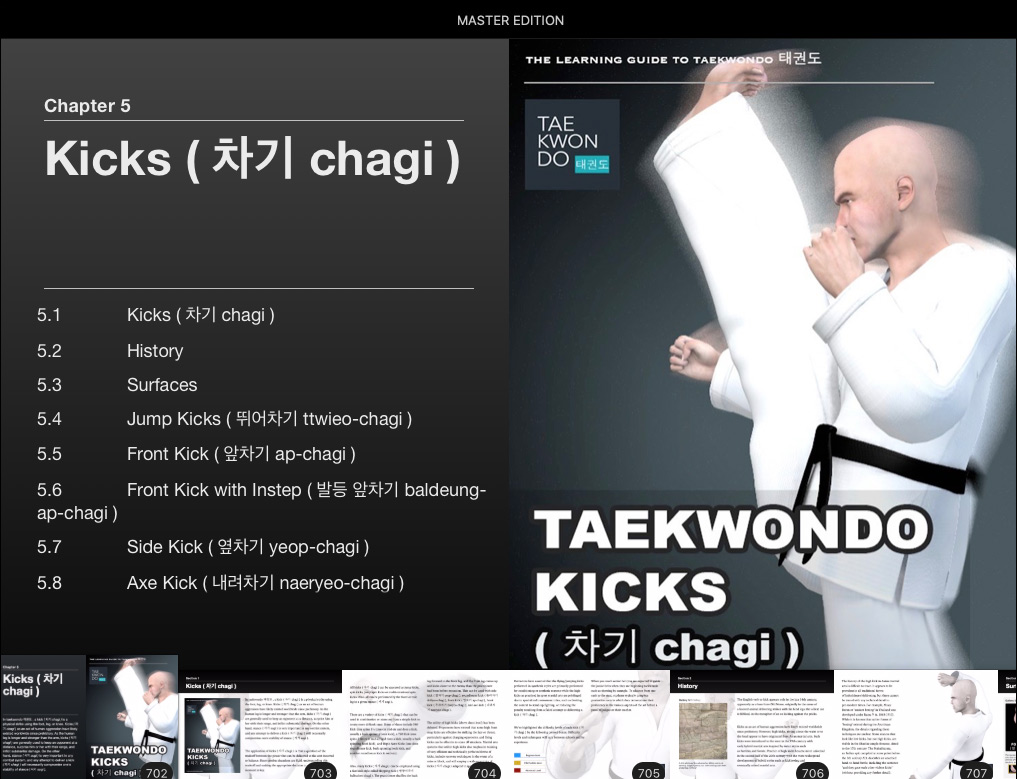
Taekwondo Preschool Master Edition

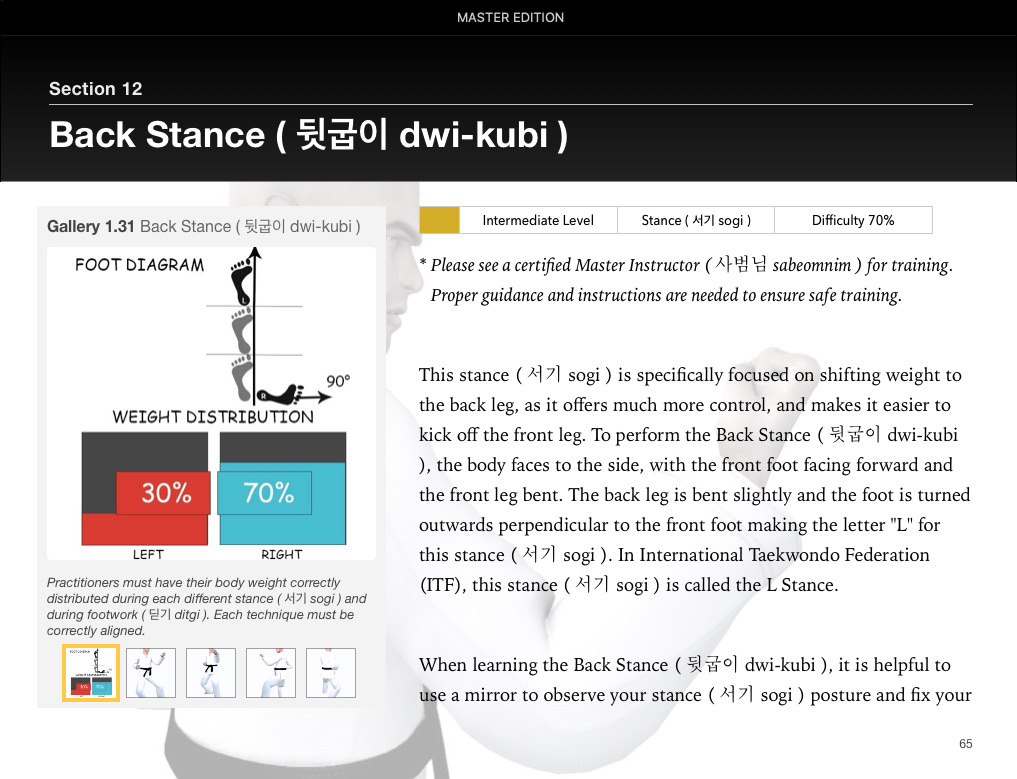
Taekwondo Preschool Master Edition
Sample: The Back Stance ( 뒷굽이 dwi-kubi ) is specifically focused on shifting weight to the back leg, as it offers much more control, and makes it easier to kick off the front leg


Taekwondo Preschool Master Edition
Sample: The Keumgang Punch ( 금강지르기 keumgang-jireugi ) is an advanced technique that requires you to punch ( 지르기 jireugi ) and block upwards ( 올려막기 olgul makgi ) at the same time


Taekwondo Preschool Master Edition
Sample: Hammer Fist Outward Strike ( 메주먹 바깥치기 mejumeok-bakkat-chigi ) is an intermediate strike that is delivered by hitting the opponent's chest to the upper area of the face with the closed fist sideways at full velocity


Taekwondo Preschool Master Edition
Sample: Back Knuckle Forward Strike ( 등주먹 앞치기 deung-jumeok-ap-chigi ) should pass over from the opposite waist to the armpit, to the chin level and then hitting with the back of the fist to the opponent's face


Taekwondo Preschool Master Edition
Sample: Knife Hand Inward Strike ( 손날 안치기 sonnal-an-chigi ) is an intermediate technique that is executed by striking with the muscle at the side of the hand located between the base of the small finger and the wrist


Taekwondo Preschool Master Edition
Sample: The Scissors Kick ( 가위차기 kawi-chagi ) is delivered while in the air moving forward into two opponents simultaneously after a running start to gain forward momentum

( Click image for additional information)

Quiz
Question. What is the korean terminology for Attention Stance?
Attention is a stance ( 서기 sogi ) where your body is in an upright standing position with the legs side by side, heels touching, distribute 50/50 weight ratio on the left and right legs, and toes facing straight forward. Your hands should be parallel with your body, to the side as your hands tap the legs.
What is the korean terminology for Attention Stance?
Answer you gave was: ( 그만 keu-man )
Your answer is wrong! You need to study more!
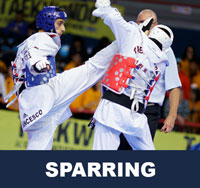

Keu-man ( 그만 ) means to stop a sparring match or poomse. Sparring is a full-contact event and takes place between two competitors in an area measuring 8 meters square. A poomse or form is a detailed pattern of defense-and-attack motions and techniques used in traditional martial arts. Poomse is the foundation for the teaching of taekwondo.
View Korean Terminology »
What is the korean terminology for Attention Stance?
Answer you gave was: ( 차렷 charyeot )
Your answer is correct! Great Job!


Attention is a stance where your body is in an upright standing position with the legs side by side, heels touching, toes facing straight forward. From this stance instructors explain what will be taught during the class session and/or if they want your attention they say Charyeot, meaning you stop whatever you are doing and get into the stance awaiting further instructions. This is the stance ( 서기 sogi ) that all bows ( 경례 gyeong-nye ) come from and is one of the most basic techniques to learn when starting taekwondo as a beginner.
What is the korean terminology for Attention Stance?
Answer you gave was: ( 기합 kihap )
Your answer is wrong! You need to study more!
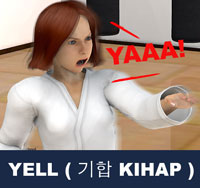

Kihap 기합 is a korean term used in taekwondo which is commonly referred to as a shout or yell made before, during, or after a technique. There are numerous examples of this battle cry in other martial arts: kihap is perhaps primarily a development of this. Students also use kihap to startle an opponent, intimidate, express confidence, or express victory in sparring competitions, self-defense ( 호신술 hosinsool ), or breaking ( 격파 gyeokpa ) applications.
View Yell ( 기합 kihap ) »
What is the korean terminology for Attention Stance?
Answer you gave was: ( 경례 gyeong-nye )
Your answer is wrong! You need to study more!
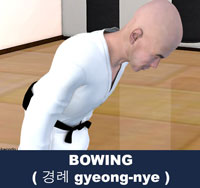

Bowing ( 경례 gyeong-nye ) is the act of lowering the torso and head as a gesture in direction to another person (Master Instructor 사범님 sabeomnim ) or symbol (flag). Bowing is an integral part of traditional martial arts such as Taekwondo. Bows are used to begin and end practice, sparring bouts and competitions, and when entering and leaving the dojang, or practice room.
Question. What year was Taekwondo an official Olympic Demonstration Sport in Seoul, Korea?
Taekwondo made its first appearance at the Summer Olympic Games as a demonstration sport at the Summer Olympics in Seoul, South Korea. The opening ceremony featured a mass demonstration of taekwondo with hundreds of adults and children performing moves in unison. Taekwondo was again a demonstration sport at the Summer Olympics in Barcelona, Spain. There were no demonstration sports at the Summer Olympics in Atlanta, USA.
What year was Taekwondo an official Olympic Demonstration Sport in Seoul, Korea?
Answer you gave was: 1992
Your answer is wrong! You need to study more!


In 1982, taekwondo was designated an official demonstration sport for the 1988 Olympic Games in Seoul, Korea, and for the 1992 Olympic Games in Barcelona, Spain. Taekwondo made its first appearance at the Summer Olympic Games as a demonstration sport at the 1988 Summer Olympics in Seoul, South Korea. The opening ceremony featured a mass demonstration of taekwondo with hundreds of adults and children performing moves in unison.
View Olympic Games »
What year was Taekwondo an official Olympic Demonstration Sport in Seoul, Korea?
Answer you gave was: 1988
Your answer is correct! Great Job!


In 1982, taekwondo was designated an official demonstration sport for the 1988 Olympic Games in Seoul, Korea, and for the 1992 Olympic Games in Barcelona, Spain. Taekwondo made its first appearance at the Summer Olympic Games as a demonstration sport at the 1988 Summer Olympics in Seoul, South Korea. The opening ceremony featured a mass demonstration of taekwondo with hundreds of adults and children performing moves in unison.
View Olympic Games »
What year was Taekwondo an official Olympic Demonstration Sport in Seoul, Korea?
Answer you gave was: 2000
Your answer is wrong! You need to study more!


In 1982, taekwondo was designated an official demonstration sport for the 1988 Olympic Games in Seoul, Korea, and for the 1992 Olympic Games in Barcelona, Spain. Taekwondo made its first appearance at the Summer Olympic Games as a demonstration sport at the 1988 Summer Olympics in Seoul, South Korea. The opening ceremony featured a mass demonstration of taekwondo with hundreds of adults and children performing moves in unison.
View Olympic Games »
What year was Taekwondo an official Olympic Demonstration Sport in Seoul, Korea?
Answer you gave was: 1996
Your answer is wrong! You need to study more!


In 1982, taekwondo was designated an official demonstration sport for the 1988 Olympic Games in Seoul, Korea, and for the 1992 Olympic Games in Barcelona, Spain. Taekwondo made its first appearance at the Summer Olympic Games as a demonstration sport at the 1988 Summer Olympics in Seoul, South Korea. The opening ceremony featured a mass demonstration of taekwondo with hundreds of adults and children performing moves in unison.
View Olympic Games »
Question. What is the korean terminology for Low Block?
The Low Block is one of the most basic Taekwondo blocks ( 막기 makgi ) and one of the first things a beginner will learn. The lead forearm is bent and raised to shoulder height, snapping the arm straight down with the palm ( 손바닥 sonbadak ) facing the ground, which blocks any incoming low kicks ( 차기 chagi ) or low strikes.
Question. What is the korean terminology for Low Block?
Answer you gave was: ( 아래막기 arae-makgi )
Your answer is correct! Great Job!

The Low Block ( 아래막기 arae-makgi ) is one of the most basic Taekwondo blocks ( 막기 makgi ) and one of the first things a beginner will learn. The lead forearm is bent and raised to shoulder height, snapping the arm straight down with the palm ( 손바닥 sonbadak ) facing the ground, which blocks any incoming low kicks ( 차기 chagi ) or low strikes.
Question. What is the korean terminology for Low Block?
Answer you gave was: ( 바깥막기 momtong bakkat makgi )
Your answer is wrong! You need to study more!

An Outside Middle Block ( 바깥막기 momtong-bakkat-makgi ) deflects a strike away from the defender leaving an opportunity for a counterattack. For example, against a straight punch ( 지르기 jireugi ) to the chest area, an Outside Middle Block ( 바깥막기 momtong-bakkat-makgi ) would aim to meet the forearm of the attacker, pushing the punch ( 지르기 jireugi ) outwards causing it to miss, and then most commonly leaving the defender slightly to the side to counterattack the opponent.
Question. What is the korean terminology for Low Block?
Answer you gave was: ( 몸통막기 momtong makgi )
Your answer is wrong! You need to study more!

An inside Middle Block ( 몸통막기 momtong-makgi ) deflects a strike away from the defender and away from the attacker. For example, against a straight punch ( 지르기 jireugi ) to the face, an inside forearm block would aim to meet the inside of the forearm of the attacker, pushing the punch ( 지르기 jireugi ) outward, leaving the opponent open for a counter attack.
Question. What is the korean terminology for Low Block?
Answer you gave was: ( 올려막기 olgul makgi )
Your answer is wrong! You need to study more!

The High Block ( 올려막기 olgul-makgi ) deflects a downward strike such as a Hammer Fist Downward Strike ( 메주먹 내려치기 mejumeok-naeryeo-chigi ), a stick attack from above, a face punch from a taller opponent, or possibly a kick like the Axe Kick ( 내려차기 naeryeo-chagi ). The blocking arm starts low with the hand in a relaxed fist ( 주먹 jumeok ) across the abdomen (over the belt) with the palm ( 손바닥 sonbadak ) facing upward.
Question. What is the korean terminology for Walking Stance?
The Walking Stance is a beginner stance ( 서기 sogi ) that is used to approach or retreat in combat and poomse. Feet should be maintained approximately 3 foot-length from origin. To maintain a solid base, the front foot is facing straight forward and the back foot is 30 degrees to aid balance.
Question. What is the korean terminology for Walking Stance?
Answer you gave was: ( 주춤서기 juchum sogi )
Your answer is wrong! You need to study more!

The Horse-Riding Stance ( 주춤서기 juchum-sogi ) is a beginner stance ( 서기 sogi ) generally used to practice punches ( 지르기 jireugi ) and blocks ( 막기 makgi ). It is similar to the Ready Stance ( 기본준비 junbi ) but the feet are placed much wider, about two-foot length's apart. Also, the knees ( 무릎 mureup ) are deeply bent and the shins ( 정강이 jeonggangi ) should be kept slightly perpendicular to the floor.
Question. What is the korean terminology for Walking Stance?
Answer you gave was: ( 기본준비 junbi )
Your answer is wrong! You need to study more!

Ready Stance ( 기본준비 junbi ) is performed by standing with the feet one foot-length from origin apart, measured from the inside edge or namely the Reverse Foot Blade ( 발날등 balnaldeung ) of the feet. The arms are slightly bent and the fists held tightly about one fist size apart just below the belly button and the fists should be a fist size away from the body. The stance ( 서기 sogi ) is one of the most important techniques to learn when starting taekwondo as a beginner.
Question. What is the korean terminology for Walking Stance?
Answer you gave was: ( 앞굽이 ap kubi )
Your answer is wrong! You need to study more!

Front Stance ( 앞굽이 ap-kubi ) is one of the most important techniques to learn when starting taekwondo as a beginner. The distance between the inside edges or namely the Reverse Foot Blade ( 발날등 balnaldeung ) of both feet should be between one to two fists apart and is about 4 to 4 one-half foot-length from origin. Rear toes are turned outward about 30 degrees and the body is also naturally angled at 30 degrees or facing straight forward depending on the upper body technique.
Question. What is the korean terminology for Walking Stance?
Answer you gave was: ( 앞서기 ap sogi )
Your answer is correct! Great Job!

The Walking Stance ( 앞서기 ap-sogi ) is a beginner stance ( 서기 sogi ) that is used to approach or retreat in combat and patterns ( 품새 poomse ). Feet should be maintained approximately 3 foot-length from origin. To maintain a solid base, the front foot is facing straight forward and the back foot is 30 degrees to aid balance. Use of this stance ( 서기 sogi ) is featured prominently in many of the World Taekwondo (WT) Poomse.
Advertisement
Risk of injury can be reduced by completing an effective warm up consisting of a heart raiser to get your pulse up, followed by sport specific dynamic stretches (stretches whilst moving). Please follow the guidance of a certified Master Instructor or trainer when doing sports related activities. Depending on the intensity of the exercise, cooling down can involve a slow jog or walk, or with lower intensities, stretching can be used. Cooling down allows the heart rate to return to its resting rate. View more information on Warming Up and Cooling Down ».
This article uses material from the Wikipedia articles "Warming Up" and "Cooling Down", which is released under the Creative Commons Attribution-Share-Alike License 3.0.
RESOURCES
This article uses material from the Wikipedia article "Sparring" which is released under the Creative Commons Attribution-Share-Alike License 3.0.








